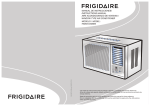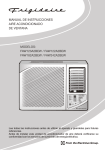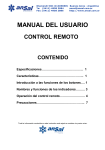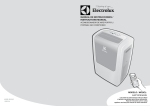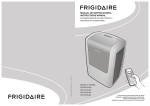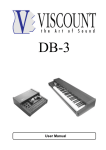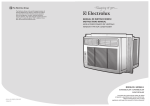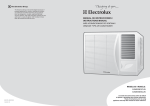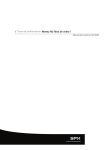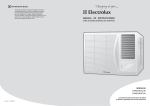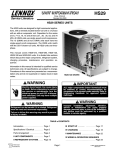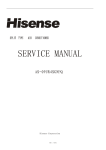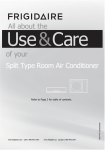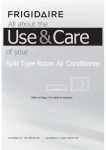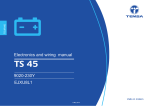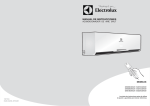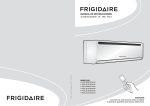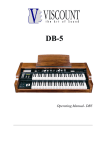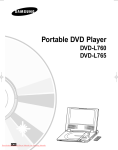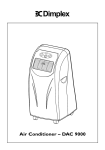Download MANUAL DE INSTRUCCIONES (INSTRUCTIONS MANUAL
Transcript
MANUAL DE INSTRUCCIONES (INSTRUCTIONS MANUAL) AIRE ACONDICIONADO DE VENTANA (WINDOW-TYPE AIR CONDITIONER) MODELOS (MODELS): FAW122C2DW / FAW092C2DW ATENCION: Lea todas las instrucciones antes de utilizar el aparato y guardelas para futuras referencias. Antes de instalar este aparato deberá verificarse su conformidad con los servicios de suministro de energía eléctrica. ATTENTION: Read all instructions prior to using appliance and keep this manual for future reference. Prior to installation this air-conditioning unit must be submitted for approval by the utility service which provides electricity. Gracias por elegir Frigidaire como marca para su acondicionador de aire. Los acondicionadores de aire Frigidaire han sido concebidos bajo altísimos estándares técnicos. Poseen características especiales desarrolladas para ofrecer aun más comodidad al usuario. Para que usted pueda disfrutar todos los recursos de su nuevo acondicionador de aire, Frigidaire creó este manual. Con orientaciones simples y prácticas usted conocerá sus funciones; además aprenderá la manera de operar este aparato de modo adecuado y seguro. Lea las instrucciones sobre instalación y operación antes de utilizar su acondicionador de aire y guárdelas en un lugar seguro para futuras consultas. Frigidaire una vez más fabrica lo mejor en lo que se refiere a electrodomésticos. Consejos ambientales El material del embalaje es reciclable. Procure separar plásticos, espuma flex, papel y cartón y enviarlos a las compañias de reciclaje. De acuerdo con la directriz de la RAEE (Residuos de Aparatos Eléctricos y Electrónicos), en inglés WEEE (Waste of Electrical and Electronic Equipment), se debe colectar y disponer de los residuos de aparatos eléctricos y electrónicos separadamente. Si futuramente usted necesita desechar este electrodoméstico, NO lo haga echándolo con el resto de la basura doméstica. Sírvase enviar el aparato a los puntos de colecta de RAEE donde los haya disponibles. Lea este manual En este manual usted hallará varias sugerencias importantes acerca de cómo usar y mantener su acondicionador de aire adecuadamente. Un poco de cuidado preventivo por parte del usuario puede ahorrarle tiempo y dinero durante la vida útil de su acondicionador de aire. Usted encontrará muchas respuestas a problemas comunes en la tabla de consejos para la solución de problemas. El leer antes dicha tabla podría evitarle el llamar al Centro de Servicio Autorizado. 1 Índice Precauciones de seguridad .................................................................... 03 Antes de hacer funcionar el aparato ...................................................... 07 Identificación de las partes de la unidad ................................................. 08 Reglas de seguridad eléctrica .................................................................. 09 Instrucciones de operación ......................................................................10 Antes de usar el control remoto .................................................................16 Descripción del control remoto .................................................................17 Ajuste vertical de la corriente de aire (manual) ...........................................17 Mantenimiento y cuidados ........................................................................18 Procedimientos de instalación ................................................................. 20 Instalación de la carcasa .......................................................................... 21 Instalación de la unidad en la carcasa ................................................... 21 Instalaciones de la unidad en la pared ...................................................... 22 Pasos para instalación ............................................................................. 23 Guía para la solución de problemas ......................................................... 25 Informaciones técnicas ............................................................................ 26 Importante El acondicionador de aire que usted ha comprado puede ser ligeramente diferente de la que se muestra en las figuras de este manual, la forma en general deberá ser la misma. Lea la información referente a su operación. El aparato que usted ha comprado puede tener un enchufe diferente del que se muestra en las figuras de este manual, siendo que el que viene en el producto cumple la especificación eléctrica de su país. La instalación no está cubierta por la compra del producto. Entre en contacto con un técnico de mantenimiento autorizado para reparar o ejecutar labores de mantenimiento en esta unidad. Entre en contacto con el instalador para instalar esta unidad. El acondicionador de aire no devera ser operado por niños pequeños. Tome cuidado para que los niños pequeños no jueguen con el acondicionador de aire. Si hay necesidad de sustituir el cable de alimentación, dicha sustitución deberá ser llevada a cabo unicamente por personal autorizado. La instalación del aparato deberá llevarse a cabo de acuerdo con las normativas nacionales en materia de instalaciones eléctricas y únicamente por personal autorizado. 2 ESP ESP Bienvenido al mundo del manejo simple y sin preocupaciones La operación incorrecta del aparato, por no seguir las instrucciones, podría causar accidentes o daños. Para evitar accidentes al usuario o a otras personas, así como daños materiales, deberán tomarse en cuenta las siguientes instrucciones: Asegúrese de que no entre agua a los componentes eléctricos. ESP ESP Precauciones de seguridad Peligro de descargas eléctricas. Conecte correctamente el aparato al tomacorriente. Instale siempre un interruptor automático y un circuito de alimentación exclusivo para el aparato. Lo contrario suscita la posibilidad de descargas eléctricas o incendios causados por producción excesiva de calor. La ausencia de estos dispositivos podría ocasionar descargas eléctricas y un incendio. No haga funcionar ni detenga la unidad enchufándola por el cable de alimentación o tirando del cable de alimentación. Desconecte la alimentación eléctrica a la unidad si escucha algún ruido anormal o si esta emite olores o humo. Peligro de descarga eléctrica o de incendio causado por producción excesiva de calor. Peligro de descargas eléctricas y de incendio. No dañe ni utilice un cable de alimentación eléctrico no especificado para el producto. Peligro de descarga eléctrica o de incendio. Si el cable de alimentación está dañado, el fabricante, su agente de similar ó persona autorizada deberá sustituirlo para evitar el peligro que el estado de dicho mantenimiento o cable representa. No use el tomacorriente si está flojo o dañado. Peligro de descarga eléctrica y de incendio. No abra el aparato durante su funcionamiento. Peligro de descargas eléctricas. Mantenga cualquier arma de fuego alejada del electrodoméstico. No modifique el cable de alimentación eléctrico, ni utilice el mismo conector para otros electrodomésticos. Peligro de incendio. Peligro de descarga eléctrica o de incendio causado por producción excesiva de calor. No utilice el cable de alimentación cerca de fuentes de calor. Peligro de descargas eléctricas y de incendio. No maneje el aparato con las manos mojadas o en lugares húmedos. Peligro de descargas eléctricas. No utilice el cable de alimentación en lugares en los que haya gases inflamables o combustibles como gasolina, benceno, solventes etc. No dirija el flujo de aire en la dirección de los ocupantes de la habitación. Peligro de explosión o de accidentes. Es dañino para la salud. Asegúrese de que la puesta a tierra sea adecuada. Antes de hacer funcionar el aparato haga ventilar la habitación si habido algún escape de gas de otro aparato. La ausencia de puesta a tierra puede ocasionar descargas eléctricas. Peligro de explosión, de incendio y de accidentes 3 4 Desconecte el cable de alimentación sujetándolo por el enchufe. Podría causar descargas eléctricas y fallas en su funcionamiento. Peligro de descargas eléctricas y daños al aparato cuando desconectado por el cable. No beba el agua drenada del acondicionador de aire. Contiene agentes contaminantes que pueden resultar dañinos para la salud. Siempre compruebe la instalación correcta de los filtros y límpielos cada dos semanas. Cuando vaya a reemplazar el filtro de aire, no toque las partes de metal del aparato. Hacer funcionar el aparato sin los filtros puede ocasionar averías. Peligro de accidentes. No ponga objetos pesados sobre el cable de alimentación eléctrico y asegúrese de no aplastar dicho cable. No limpie el acondicionador de aire con agua. Peligro de incendio o descargas eléctricas. El agua podría penetrar en la unidad y deteriorar su aislamiento. Peligro de descargas eléctricas. No use los siguientes artículos: En presencia de estufas etc. ventile bien el recinto Podría faltar oxígeno. Cuando vaya a limpiar la unidad, desconéctela del tomacorriente y desconecte también el interruptor automático. No limpie la unidad mientras está conectada pues existe peligro de causar un incendio, descargas eléctricas o accidentes. No exponga plantas o animales al flujo directo del aire. Peligro para la salud del animal o para la planta. Tome cuidado al desempacar y instalar la unidad. Los bordes afilados podrían causarle accidentes. Agua tibia (a más de 40°C ó 104°F). El agua tibia podría deformar o descolorir el aire acondicionado de pared. Gasolina, solventes, benceno y objetos abrasivos etc. pueden causar deformaciones al aparato o rasguñarlo. No utilize para propósitos especiales. No utilize ese acondicionador de aire para preservar instrumentos de precisión, comida, animales, plantas y objetos de arte. Eso puede perjudicar su calidad, etc. Desenchufe el disyuntor principal de fuerza cuando no vaya a utilizar la unidad por un amplio período de tiempo. Puede ocasionar falla del producto o incendio. Asegúrese que el soporte de instalación del aparato externo no este roto. Si el soporte está roto, hay la posibilidad de daño debido a la caída de la unidad. Apague el acondicionador de aire en caso de tormenta o de condiciones climáticas adversas. El funcionamiento del aparato con las ventanas abiertas puede causar la penetración de agua al interior y el humedecimiento de los muebles. No ponga objetos cerca de las entradas de aire o en las salidas de aire. Peligro de averías al aparato o de accidentes. 5 Importante Si entra agua en la unidad, desenchúfela y desenchufe también el interruptor principal. Aisle la unidad sacando el cable de alimentación de la toma eléctrica y contacte el servicio técnico calificado. 6 ESP ESP No desarme ni modifique el aparato. Identificación de las partes de la unidad Preparando el aparato para hacerlo funcionar 1. Contacte al técnico de servicio autorizado para instalación. 2. Conecte correctamente el aparato al tomacorriente. 3. No dañe, ni utilice un cable de alimentación eléctrico no especificado para el producto. 4. No utilice el mismo tomacorriente para conectar otros electrodomésticos. 5. No utilice una extensión en el cable de alimentación. 6. No haga funcionar ni detenga la unidad enchufándola por el cable de alimentación o tirando del cable de alimentación. 1 Panel frontal Uso 1. Exposición al flujo de aire directo por un amplio período de tiempo puede ser peligroso para su salud. No exponga ocupantes, plantas o animales al flujo directo del aire. 2. En presencia de estufas etc. ventile bien el recinto pues puede producirse una falta de oxígeno. 3. No utilize ese acondicionador de aire para preservar instrumentos de precisión, comida, animales, plantas y objetos de arte. Eso puede perjudicar su calidad, etc. 8 Cable de alimentación eléctrico Mantenimiento y cuidados 1. Cuando vaya a reemplazar el filtro de aire, no toque las partes de metal del aparato. Hay riesgo de lesiones personales. 2. No limpie el acondicionador de aire con agua. El agua podría penetrar en la unidad y deteriorar su aislamiento, con peligro de choque eléctrico. 3. Cuando vaya a limpiar la unidad, desconéctela del tomacorriente y desconecte también el interruptor automático. ESP ESP Antes de hacer funcionar el aparato 2 Filtro de aire 3 Marco 4 Gabinete 5 Rejilla de la entrada de aire (lado exterior) Power 9 6 Rejilla de la salida de aire Mode 7 Panel de control 4 9 Control remoto 5 3 2 1 6 7 8 Temperatura de operación MODO DE REFRIGERACIÓN MODO DE CALEFACCIÓN Temperatura Externa 18 ~ 43 ºC (T1 Ambiente) 21 ~ 52 ºC (T3 Ambiente) Temperatura Interna 18 ~ 32 ºC (T1 Ambiente) 18 ~ 32 ºC (T3 Ambiente) Temperatura Externa -5 ~ -24 ºC (T1 Ambiente) -7 ~ -24 ºC (T3 Ambiente) Temperatura Interna 0 ~ -27 ºC (T1 Ambiente) 0 ~ -30 ºC (T3 Ambiente) Si se hace funcionar la unidad en condiciones más allá de lo indicado arriba, esta podría presentar fallas. 7 Observación La descripción del panel de control se basa en un modelo típico, la función es la misma de su acondicionador de aire aunque pueda haber algunas diferencias en su apariencia. 8 Cuidado Todo el cableado debe estar de acuerdo con los códigos y leyes para el uso de energía eléctrica locales y debe ser instalado por un electricista calificado. Si tiene alguna duda acerca de las instrucciones que están a continuación, consulte a un electricista calificado. Nunca introduzca los dedos o cualquier objeto extraño en la salida de aire. Tome especial cuidado en advertir a los niños acerca de los peligros de hacerlo. Para evitar posibles daños físicos, asegúrese de desconectar el suministro de energía a la unidad antes de instalarla, llevar a cabo labores de mantenimiento y/o limpiarla. Si el cable de alimentación está damnificado, el fabricante, su agente de servicio o similar persona autorizada deberá sustituirlo para evitar el peligro que el estado de dicho cable representa. Instrucciones de operación Para los requisitos eléctricos, lea la Informaciones técnicas (pag.26) Asegúrese de que la unidad esté adecuadamente conectada a tierra. El tomacorriente deberá ser de fácil acceso después de instalar el equipo y deberá estar provisto de un cable a tierra confiable. Para su seguridad y protección, esta unidad está conectada a tierra con el cable de alimentación (ver la fig. 2). Por favor entre en contacto con el fabricante o su agente de servicio o similar persona autorizada si usted desea sustituirlo. 9 El teclado del control electrónico será como uno de los que siguientes: Para los modelos con ciclo frío/calor: La unidad deberá estar conectada a un circuito independiente y el amperaje del fusible deberá ser igual al del cable de alimentación y del tomacorriente. L Para los modelos con ciclo frío: E N Cable De Alimentación AUTO AUTO Fig. 1 E - Cable a tierra, amarillo/verde N - Conductor neutro, azul L - Cable bajo tensión, marrón Tomacorriente Power (Encend./Apagar): Presione la tecla para encender o apagar la unidad. (La tecla TIMER controla la función INICIAR/PARAR de la unidad.) Fig. 2 Mode (Función): Presione la tecla "MODE” para escoger el modo de funcionamiento deseado. Para los modelos de refrigeración & calefacción, la selección de modo ofrece las opciones AUTO, CALOR , FRIO, VENT. (Solo Vent.) y DRY (Seco). Atención Es posible distinguir el cable de alimentación por su color, como se indica a continuación (ver la fig. 1): Panel del control ESP ESP Reglas de seguridad eléctrica POWER MODE MODE SIGNS AUTO Auto CALOR FRIO VENT. DRY 10 Dry (Solo para algunos modelos): Este modo se utiliza para reducir la humedad de la habitación. Frio: Se puede definir la temperatura entre 16 ºC y 31 ºC. La refrigeración empieza automáticamente cuando la temperatura de la habitación está 1 ºC arriba de la temperatura de ajuste, y se detiene cuando la temperatura llega a 1 ºC menos que la temperatura de ajuste. El ventilador no se detiene. Calor (Sólo para los modelos con calefacción): En el modo de calefacción se puede ajustar la temperatura entre 16 ºC y 31 ºC. La temperatura definida por defecto es 24 ºC en el modo de calefacción y la velocidad del ventilador es optativa. Observaciones: 1. Después de cambiar el ajuste 11 Modelo frío/calor: Modelo frío: Auto MODE MODE FUNCION FUNCION de temperatura, el motor del ventilador funciona primero en BAJA velocidad por 3 minutos para salvaguardar el compresor antes de que la calefacción empieze. 2. Cuando la calefacción para, puede haber un ligero retardo de 30 segundos hasta que el motor del ventilador se detenga. 3. Si la temperatura del condensador está abajo de 35 ºC, el ventilador funcionará en velocidad BAJA a pesar del ajuste de la ventilación. 4. Si la temperatura del condensador es superior a 38 ºC, el ventilador funcionará de acuerdo con el ajuste de la ventilación. Auto (Automático - Sólo para algunos modelos): El motor del ventilador permanece en velocidad MEDIA en el modo AUTO. La unidad seleccionará el modo de funcionamiento apropiado entre VENT. (Sólo Ventilación), FRÍO o CALIENTE basándose en la diferencia entre la temperatura real y la temperatura deseada para la habitación. Si la temperatura real de la habitación está 2 ºC arriba de la temperatura de ajuste, la unidad funcionará en modo de refrigeración. Cuando la temperatura real de la habitación no es 2 ºC superior a la temperatura de ajuste ni tampoco 1 ºC inferior a la temperatura de ajuste, la unidad escogerá el modo de VENT. (Sólo Ventilación). Cuando la temperatura real de la habitación esté 2 ºC abajo de la temperatura de ajuste, la unidad funcionará en modo CALOR (Calefacción). Observaciones: 1. Si se activa el modo DORMIR mientras la unidad está funcionando en el modo AUTO (Automático), el motor del ventilador pasará al modo de velocidad BAJA inmediatamente. Definición de la temperatura: AUMENTAR: Presione la tecla para aumentar la temperatura (de funcionamiento) escogida. Cada vez que se presione esa tecla la temperatura aumentará de la siguiente forma: 1 ºC (en la escala Celsius) llegando hasta 31 ºC como temperatura máxima. BAJAR: Presione la tecla para reducir la temperatura (de funcionamiento) escogida. Cada vez que se presione esa tecla la temperatura bajará de la siguiente forma: 1 ºC (en la escala Celsius) llegando hasta 16 ºC como temperatura mínima. ESP ESP Para los modelos con refrigeración solamente, se puede escoger entre los modos FRIO, VENT. (Solo Vent.) y DRY (Seco - solo para algunos modelos). El indicador luminoso verde que está al lado de la opción "MODE" se encenderá identificando la opción escogida. Cuando se usa el modo DRY y AUTO, no se puede escoger la velocidad del ventilador. El modo del ventilador funciona con BAJA velocidad en el modo DRY, y con velocidad MEDIA en el modo AUTO (Automático). Aumentar Bajar 12 Timer: Presione la tecla "TIMER" para activar la función de temporización "INICIAR /PARAR automático". Los programas para iniciar/parar automáticamente pueden definirse de 0 a 12 horas. Cada vez que se presione la tecla "TIMER", el tiempo definido aumentará 1 hora. Swing (Solo para algunos modelos): Presione la tecla "SWING" (presente solamente en los modelos > 9000Bth/h) para activar la función de oscilación automática de las aletas. El indicador luminoso verde que está al lado del botón "SWING" se encenderá, indicando el modo escogido. Las aletas verticales oscilarán de un lado a otro automáticamente esparciendo el aire por la habitación brindando un enfriamiento/calefacción uniforme. Para detener esta función, presione el botón "SWING" nuevamente, el indicador luminoso verde correspondiente a ese botón se apagará. Presionando la tecla "SWING" por 2 13 segundos usted activará el modo DORMIR, el cual tiene la capacidad de reducir el ruido del aparato, creando de esta manera un ambiente más confortable para dormir. Cuando se active el modo DORMIR, el indicador luminoso verde "DORMIR" se encenderá. Vea detalles de la tecla “DORMIR” a seguir. Alta Media Baja Timer Swing Dormir: Presione y sostenga la tecla "SWING" por 2 segundos para activar el modo "DORMIR" (sólo en los modelos > 9000Btu/h). Para desactivar, presione y sostenga la tecla "SWING" por 2 segundos. Para los modelos < 9000Btu/h que no poseen la función "SWING", presione la tecla “DORMIR" en el control remoto para activar o desactivar el modo “DORMIR". En el modo de refrigeración, la temperatura de ajuste de esfriamiento aumentará 1 ºC por hora después de haber escogido el modo “DORMIR". Dos horas más tarde, el punto de ajuste continuará en la misma temperatura y el motor del ventilador continuará con la velocidad BAJA. En el modo de calefacción, el punto de ajuste de la temperatura de calefacción baja 1 ºC por hora después de haber escogido el modo “DORMIR". Dos horas más tarde, el punto de ajuste continuará en la misma temperatura y el motor del ventilador continuará con la velocidad BAJA. El uso del modo “DORMIR" reducirá el ruído creando de esta manera un ambiente ESP ESP Vent. (Ventilación): Presione a tecla VENT. para definir la velocidad de ventilación deseada. Cada vez que se la presione, la velocidad se alternará entre BAJA, MEDIA o ALTA. El indicador luminoso verde que está al lado de la opción de velocidad de VENTILACIÓN se encenderá, identificando la velocidad que se ha escogido. Swing Presione la tecla para activar la función de oscilación automática de las aletas. Swing Presionando la tecla "SWING" por 2 segundos activará el modo DORMIR Dormir confortable para dormir. Observaciones: Al activar el modo DORMIR en modo AUTO (Automático), la temperatura definida no cambiará por largo tiempo. Indicaciones de fallas: Er: Indica un mal funcionamiento del sensor de la temperatura interior de la habitación. En: Indica un mal funcionamiento del sensor de temperatura del evaporador. Eo: Indica un mal funcionamiento del sensor de la temperatura del condensador exterior. Observación: Cuando alguno de los mal funcionamientos indicados arriba ocurra, desconecte la unidad y verifique si hay alguna obstrucción. Vuelva a encender el aparato. Si el mal funcionamiento persiste, apague el aparato y desconéctelo del tomacorriente. Entre en contacto con el fabricante, con alguno de sus representantes de servicios de 14 mantenimiento o similar persona autorizada para prestar tales servicios. Ed: Indica el congelamiento de la protección (apague el aparato y enciéndalo nuevamente para que vueva a funcionar normalmente). EI: Indica la necesidad de verificar el filtro después de 720 horas de funcionamiento del ventilador. Apague la unidad, desconéctela del tomacorriente. Limpie el filtro y vuelva a conectar el aparato. Su aire acondicionado volverá a funcionar normalmente. OBSERVACIÓN: EI = limpiar el filtro de aire: La pantalla mostrará automáticamente la indicación “EI” indicando cuando se debe limpiar el filtro de aire. El programa “EI” es un dispositivo medidor de tiempo (incorporado) que funciona basado en el tiempo de funcionamiento total (del aire acondicionado). Es muy importante mantener siempre limpio el filtro de aire para que la eficiencia de la refrigeración sea óptima (lea la sección de limpieza del filtro). El filtro de aire debe limpiarse cuando aparezca el mensaje “EI” en la pantalla; se deberá apagar el aire acondicionado y desconectarlo (del tomacorriente) y después volverlo a conectar. Esta acción automáticamente reinicia el dispositivo de tiempo interno del programa “EI”. 15 La unidad de control remoto le permite controlar todos los aspectos operacionales de su acondicionador de aire, sin salir del confort de su sillón favorito. A continuación se citan algunas cosas que usted debe saber acerca de cómo operar su acondicionador de aire utilizando el control remoto. Er En Eo Ed El Control de ventilación El control de ventilación se ubica sobre las perillas de control (vea las figuras A y B). La manera de operarlo varía entre los diferentes modelos. Para obtener máxima eficiencia de refrigeración, cierre el respiradero. Hacerlo permitirá la circulación interna de aire. Abra el respiradero para descargar el aire parado. Cerrar Abrir Fig. B Cerrar Abrir Fig. A ESP ESP Antes de usar el control remoto Cargar el control remoto: Para usar el control remoto, será necesario cargarlo con dos pilas alcalinas (R03/Ir03x2) Tipo AAA. Se deberá sustituir las pilas cuando: 1. Cuando no se escucha un beep de respuesta de la unidad interna o si la luz del indicador de transmisión no aparece. 2. La unidad interna no responde a los comandos del control remoto para activar los programas. Para sustituir las pilas: 1. Deslice hacia abajo la tapa del compartimiento para las pilas (ubicada en la parte trasera del control remoto). 2. Inserte dos pilas tamaño “AAA” en el compartimiento para las pilas (como se indica en el dibujo que está dentro de ese compartimiento). 3. Vuelva a poner la tapa del compartimiento para las pilas. Importante 1. Mantenga el control remoto alejado de líquidos. 2. Proteja el control remoto de altas temperaturas y exposiciones a la radiación. 3. Mantenga el receptor interno fuera del alcance de la luz del sol. De lo contrario puede presentar fallas en el funcionamiento. 4. Mantenga el control alejado de EMI (interferencias electro magnéticas) provistas por otros artefactos electrodomésticos. 5. Al reemplazar las baterías, no utilizar viejas o de diferente tipo. Esto puede causar un mal funcionamiento del control remoto. 6. Si no se usa el control remoto por largos periodos de tiempo, (vacaciones, periodo fuera de temporada) se deberá retirar las pilas del control remoto. 7. El promedio de la vida útil de la batería en condiciones normales es de alrededor de 6 meses. 16 Mantenimiento y cuidados Filtro de aire El filtro de aire que está detrás de la rejilla de entrada de aire debe verificarse y limpiarse por lo menos una vez a cada quince días, o lo necesario para mantener un desempeño óptimo del aire acondicionado. Si la pantalla muestra la indicación “E1”, apague y desconecte del tomacorriente el aire acondicionado y limpie el filtro. : Aumenta / baja la “TEMPERATURA”. 1 TEMP. 2 ENC. / APAGAR: Enciende y apaga el aparato. 3 TIMER: Activa el programa de “encendido automático” o de “parada automática” de 0 a 12 horas (con incrementos de 1 hora). 1 4 SWING (solo para algunos modelos): Activa la función de oscilación automática de las “ALETAS” (oscilación vertical de las aletas). 5 FUNCION: Activa la función "AUTO" (automático), "CALOR" (calefacción), "FRÍO", "VENT." (solo ventilación) o "DRY" (seco). 2 3 6 4 7 5 6 VENT. (solo ventilación): Activa el ajuste de la velocidad de “VENTILACIÓN” (ALTA, MEDIA, BAJA). 7 DORMIR: Activa el modo “DORMIR” Ajuste vertical de la corriente de aire (manual) Para ajustar la dirección vertical de la corriente de aire, ajuste cualquiera de las aletas horizontales. Puede subir o bajar las aletas horizontales. Al hacerlo evita efectivamente la formación de condensación de gotas de agua sobre el panel frontal de la unidad. 17 Cómo retirar el filtro de aire 1. Se puede abrir la rejilla desde arriba o desde abajo para prestarle fácil mantenimiento después de la instalación. 2. Abra la rejilla de entrada retirando la puerta expuesta en la base o parte superior de la unidad (dependiendo de la instalación). 3. Tire levemente de la lengüeta para soltar el filtro. Tire del filtro en la misma dirección de apertura. 4. Limpie el filtro con agua jabonosa tibia. El agua no puede estar a más de 40ºC para evitar que el filtro se deforme. 5. Enjuáguelo y sacuda cuidadosamente el exceso de agua. Déjelo secar antes de volverlo a instalar. Para evitar que el filtro se deforme, no lo seque exponiéndolo directamente al sol. Tratamiento de agua condensada Para cumplir con las diferentes condiciones de los diferentes tipos de acondicionadores de aire, existen dos métodos que usted puede escoger para tratar el agua condensada. Para los modelos con refrigeración solamente: Usted puede escoger entre el método de desagüe trasero y el método sin desagüe. Fijese en los siguientes procedimientos para ejecutar el desagüe trasero: 18 ESP ESP Descripción del control remoto Junta de Desagüe Orificio Central Tapón de Caucho Empaque TOLDO TOLDO CERCA CERCA Gabinete Bandeja de Desagüe Salida de la Manguera de Desagüe Tapón de Caucho Tornillo Aprox. 10mm Más de 50cm 75-150cm Para los modelos con ciclo reverso: Usted puede escoger el desague por la base. Fijese en los siguientes procedimientos para llevar a cabo el desagüe por la base: 1. Retire la bandeja de desagüe y los tornillos (que se suministran con el acondicionador de aire). 2. Instale la bandeja de desagüe en la base de la unidad y fijela con los tornillos. 3. Conecte la manguera de desagüe a la salida que está a un lado de la bandeja de desagüe, usted puede adquirir la manguera o tubo de desagüe de acuerdo con su propia necesidad (la manguera de desagüe no viene con el acondicionador de aire). 7 Escoja el mejor lugar para la instalación: 1. Para evitar vibraciones y ruido, asegurése de instalar el acondicionador de aire de forma estable y firme. 2. Instale la unidad en un lugar en el que no reciba directamente la luz del sol. Si hay incidencia directa de rayos solares sobre la unidad, instale sobre el aparato un toldo para que le haga sombra. 3. No deberá haber ningún obstáculo, tal como una pared o una cerca, a una distancia de por lo menos 50 cm de la parte trasera del gabinete pues evitaría la radiación de calor del condensador. El restringir el aire exterior reducirá en gran medida la eficiencia de la refrigeración y de la calefacción del acondicionador de aire. 4. Instale la unidad levemente inclinada hacia afuera para que el agua condensada no gotee en el interior de la habitación (aproximadamente 10 mm ó 1/4 de burbuja en un nível de burbuja). 5. Al cable de alimentación debe estar conectado a un circuito independiente. El cable amarillo / verde debe estar conectado a tierra. 6. La unidad deberá instalarse de 75 a 150 cm sobre el nível del piso de la habitación. 75-150cm ESP 1. Encaje el empaque en la junta de desagüe (que viene con su acondicionador de aire). 2. Retire el tapón de caucho de la parte trasera de la unidad. 3. Conecte la junta de desagüe detrás del gabinete en el lugar del que retiró el tapón de caucho y gírelo 90º para que quede bien ajustado. 4. Conecte la junta de desagüe a una manguera de desagüe (usted deberá adquirirla separadamente). Aprox. 10mm Más de 50cm Cuidado Todas rejillas deverán estar para fuera de la estructura, como la figura arriba. 19 20 ESP Procedimientos de instalación Paso 1: Retire el acondicionador de aire de su embalaje, retire los tornillos fijadores y deslícelo hacia afuera de su carcasa (Lea los pasos de instalación). Paso 2: Prepare el hueco en la pared para que el fondo de la carcasa esté bien apoyado, para que haya un espacio mínimo sobre la parte superior y para que las rejillas para la entrada de aire estén despejadas como se muestra en las opciones A y B. Los huecos desde afuera en dirección a la cavidad deberán sellarse. La carcasa deberá estar ligeramente inclinada hacia atrás aproximadamente 5 mm para permitir que el agua que se forma debido al funcionamiento del aparato pueda drenarse con facilidad. Paso 3: Instale la unidad en la pared y fijela bien. Asegúrese de que los empaques de espuma no están dañados. Cubra, selle o rellene los espacios alrededor del aparato, por dentro y por fuera para proporcionar una aparencia satisfactoria y para protegerlo contra la intemperie, los insectos y roedores. Cubra o selle alrededor del marco en la pared exterior o arquitrabe de cable bajo el aparato. Paso 3: Acople los soportes de fijación del chasis al canal de la parte de abajo de la carcasa y fijelos a la base con el tornillo suministrado. Paso 4: Retire el panel delantero de su embalaje de cartón y de la bolsa plástica y encájelo como indican las instucciones de instalación. Paso 5: Encienda la unidad. Verifique si está funcionando adecuadamente y verifique si hay vibración en la instalación. Paso 6: Encaje la bandeja de desagüe en la carcasa y si es necesario tienda la línea de desagüe en la dirección adecuada. Cubra o selle alrededor del marco en la pared exterior o arquitrabe. Asegúrese de que las rejillas están completamente fuera de la pared. Bandeja de desagüe Marco de madera resistente Pared con marco de madera o partición Marco de madera resistente alrededor de la unidad. Pared con marco de madera o partición Apoyo de estabilización (uno a cada lado) Apoyo Sólido de Madera Método alternativo de instalación en el caso de no ser posible disponer de un apoyo exterior Bandeja de desagüe Marco de apoyo externo en el punto de equilibrio del acondicionador de aire. Alternativamente pueden usarse soportes de apoyo como se muestra más abajo Instalaciones de la unidad en la pared Deben considerarse como métodos preferenciales de instalación la instalación en hueco con marco de madera, en una partición o ventana. Corte biselado a Salida 45º para dejar las rejillas despejadas. Entrada de aire Entrada de aire Instalación de la unidad en la carcasa Paso 1: Deslice la unidad hacia adentro de su carcasa hasta que esté firmemente apoyada contra la parte trasera de esta. Tome cuidado para que las tiras de sello de espuma no se salgan de su lugar. Paso 2: Conecte el acondicionador de aire al tomacorriente y ponga el exceso 21 de Aire Pared Pared 100mm Entrada de Aire Entrada de aire Entrada de Aire Salida de aire 100mm 100mm Salida de Aire OPCIÓN A OPCIÓN B 22 ESP ESP Instalación de la carcasa Paso 1: Retire el panel frontal y el filtro de aire. 1. Sujete de la ranura bajo el panel frontal, luego levántelo hacia adelante y después retírelo (ver la fig. 1). 2. Apriete la agarradera bajo el filtro de aire y arquee el filtro de aire, retírelo de la ranura de abajo hacia arriba (ver la fig. 2) aparato, por dentro y por fuera para proporcionar una aparencia satisfactoria y para protegerlo contra la intemperie, los insectos y roedores. Paso 2: Retire el marco. 1. Retire los dos tornillos fijos del marco (ver la fig. 3). 2. Sujete la esquina izquierda en el lado inferior del marco, luego aflójelo (ver la fig. 4). Paso 3: Instalación 1. Retire los tornillos que sujetan la placa de fijación al chasis y al gabinete. Algunos modelos poseen dos tornillos más detrás del gabinete (ver la fig. 5). Fig. 1 7 Fig. 2 Fig. 3 Fig. 4 Fig. 5 23 2. Sujete la agarradera en el chasis y cuidadosamente deslice el aire acondicionado hacia afuera del gabinete (ver la fig. 6) 3. Retire la almohadilla de empaque del compresor antes de poner en marcha el acondicionador de aire y asegúrese de que los puntos de descarga que van a la bandeja de desagüe están alineados antes de empujar el chasis hacia adentro del gabinete (vea la fig. 7). 4. Empuje el chasis de la unidad hacia adentro del gabinete (ver la fig. 8). 5. Fije el chasis y el gabinete (ver la fig. 5). ESP ESP Pasos para instalación Fig. 6 Tornillos Pared Fig. 7 Paso 4: Instale el marco. 1. Instale el marco y conecte los tapones de acople tomando cuidado para no aplastar el cable del sensor de temperatura (ver la fig. 9). 2. Fije los tornillos en el marco (ver la fig. 3). Paso 5: Instale el panel frontal y el filtro de aire. 1. Instale el filtro de aire en la ranura del marco de arriba hacia abajo (ver la fig. 2). 2. Cuelgue el panel frontal en el broche del marco, luego presione el panel frontal contra la ranura del marco hasta oír un “click” que denote el encaje (ver la fig. 10). Gabinete Apoyo Fig. 8 Fig. 9 Fig. 10 24 Si su aire acondicionado presenta problemas de funcionamiento, verifique en la tabla a seguir las probables causas y soluciones. Si estas sugerencias no solucionan su problema, llame al Centro de Servicio Autorizado. El desempeño del aparato es insatisfactorio. Informaciones técnicas AIRE ACONDICIONADO DE VENTANA (Modelos Fríos) Modelo Tamaño del 2 Dimensiones / mm (AxHxP) Cableado ( mm ) Voltaje/ Frecuencia ESP ESP Guía para la solución de problemas Capacidad (Btu) Peso (kg) FAW092C2DW 450x345x540 mm 1,0 mm 2 220-230 V / 60 Hz 9000 Btu 35 kg FAW122C2DW 685x420x620 mm 1,5 mm 2 220-230 V / 60 Hz 12000 Btu 39 kg La salida o la entrada de aire del lado exterior está obstruida. La temperatura en el exterior está anormalmente alta debido a la incidencia directa de rayos solares o de alguna otra fuente de calor. Se está cocinando o usando un calefactor de agua en la misma habitación. Hay demasiada gente en la habitación. El filtro de aire está obstruido con polvo. La palanca de ventilación está en la posición abierta. El termostato regulador de la temperatura no se ha ajustado correctamente. La parte frontal del aparato está obstruida. Direccionadores verticales totalmente cerrados. Hielo en el evaporador. La capacidad del producto es inadecuada para el tamaño del ambiente. Si el aire acondicionado no funciona. El enchufe no está devidamente conectado al tomacorriente. Falta de energía eléctrica en el tomacorriente. La tensión de la red eléctrica no es la correcta. La temperatura está mal ajustada. Ver si el fusible se ha quemado. El compresor no prende. Unicamente la ventilación funciona. Aparato apagado recientemente. Caída o sobrecarga momentánea en la red eléctrica. Baja tensión en la red. Ajuste del botón temperatura. Ruido Instalación inadecuada. Salida del agua de condensación deficiente. Pérdida de agua en el ambiente. Instalación con nivelado incorrecto. 25 26 Thank you for choosing Frigidaire for your air conditioner. Our air conditioners are developed with high technical and quality standards, with features to offer you even more comfort. Read all instructions before using this appliance. This book contains valuable information about operation, care and service. Keep it in a safe place. You expect all this from Frigidaire…and we deliver. Your laundry never looked so good. Environmental advice The packaging material used is recyclable; we recommend that you separate plastic, paper and cardboard and give them to recycling companies. According to WEEE (Waste of Electrical and Electronic Equipment) guidelines, waste from electrical and electronic devices should be collected separately. If you need to dispose of this appliance in the future, do NOT throw it away with the rest of your domestic garbage. Instead, please take the appliance to the nearest WEEE collection point, where available. Read this manual Inside you will find many helpful hints on how to use and maintain your air conditioner properly. Just a little preventive care on your part can save you a great deal of time and money over the life of your air conditioner. You'll find many answers to common problems in the chart of troubleshooting tips. If you review our chart of Troubleshooting Tips first, you may not need to call for service at all. 27 Contents Safety ....................................................................................................... 29 Prior to operation ...................................................................................... 33 Unit parts identification ............................................................................. 34 Electrical safety rules ................................................................................ 35 Operation instruction ................................................................................ 36 Before using the remote control ................................................................ 42 Control remote description ....................................................................... 43 Vertical air flow adjustment (manually) ...................................................... 43 Cleaning and maintenance .......................................................................44 Installation instructions ............................................................................ 46 Installation of the housing.......................................................................... 47 Installation of the unit into the housing ................................................... 47 Installations of the unit into the wall ...................................................... 47 Installation steps ...................................................................................... 49 Troubleshooting ....................................................................................... 51 Technical information .............................................................................. 52 Important The appliance that you have bought may be slightly different from the one illustrated in this manual. Please refer to the information related to the model you have. The appliance you have may carry a different plug than the one illustrated in this manual. The plug that comes with the product follows the electrical specification of the country where it is sold. The installation is not covered by the purchase of the product. Contact the authorised service technician for repair or maintenance of this unit. Contact the installer for installation of this unit. The air conditioner cannot be use by childrens. Young children should be supervised to ensure that they do not play with the air conditioner. If the power cord is to be replaced, replacement work shall be performed by authorised personnel only. Installation work must be performed in accordance with the national wiring standards by authorised personnel only. 28 ENG ENG Welcome to the world of simple handling and no worries. Safety ENG Plug in power plug properly. Otherwise, it may cause electric shock or fire due to excess heat generation. Do not operate or stop the unit by inserting or pulling out the power plug. It may cause electric shock or fire due to heat generation. Do not use the socket if it is loose or damaged. It may cause fire and electric shock. Do not open the unit during operation. It may cause electric shock. Keep firearms away. It may cause fire. Do not damage or use an unspecified power cord. Do not use the power cord close to heating appliances. • It may cause electric shock or fire. • If the power cord is damaged, it must be replaced by the manufacturer or an authorised service centre or a similarly qualified person in order to avoid a hazard. It may cause fire and electric shock. Do not modify power cord length or share the outlet with other appliances. It may cause electric shock or fire due to heat generation. ENG Incorrect operation due to ignoring of instructions may cause harm or damage. The seriousness is classified by the following indications Do not use the power cord near flammable gas or combustibles, such as gasoline, benzene, thinner, etc. It may cause an explosion or fire. Do not operate with wet hands or in damp environment. Ventilate room before operating air conditioner if there is a gas leakage from another appliance. It may cause electric shock. It may cause explosion, fire and, burns. Do not direct airflow at room occupants only. Do not disassemble or modify unit. This could damage your health. It may cause failure and electric shock. Always ensure effective earthing. Do not drink water drained from air conditioner. Incorrect earthing may cause electric shock. It contains contaminants and could make you sick. Do not allow water to run into electric parts. When the air filter is to be removed, do not touch the metal parts of the unit. It may cause failure of machine or electric shock. Always install circuit breaker and a dedicated power circuit. It may cause an injury. Do not clean the air conditioner with water. Incorrect installation may cause fire and electric shock. • Water may enter the unit and degrade the insulation. • It may cause an electric shock. Unplug the unit if strange sounds, smell, or smoke comes from it. Ventilate the room well when used together with a stove, etc. It may cause fire and electric shock. An oxygen shortage may occur. 29 30 Do not use for special purposes. Do not clean unit when power is on as it may cause fire and electric shock, it may cause an injury. Do not use this air conditioner to preserve precision devices, food, pets, plants, and art objects. It may cause deterioration of quality, etc. Do not put a pet or house plant where it will be exposed to direct air flow. Turn off the main power switch when not using the unit for a long time. This could injure the pet or plant. It may cause failure of product or fire. Use caution when unpacking and installing. Ensure that the installation bracket of the outdoor appliance is not damaged due to prolonged exposure. Sharp edges could cause injury. ENG ENG When the unit is to be cleaned, switch off, and turn off the circuit breaker. If bracket is damaged, there is concern of damage due to falling of unit. Stop operation and close the window in storm or hurricane. Operation with windows opened may cause wetting of indoor and soaking of household furniture. Do not place obstacles around air-inlets or inside of air-outlet. It may cause failure of appliance or accident. Important If water enters the unit, turn the unit off at the power outlet and switch off the circuit breaker. Isolate supply by taking the power-plug out and contact a qualified service technician. Hold the plug by the head of the power plug when taking it out. It may cause electric shock and damage. Always insert the filters securely. Clean filter once every two weeks. Operation without filters may cause failure. Do not place heavy object on the power cord and ensure that the cord is not compressed. There is danger of fire or electric shock. Do not use the following items. Warm water (more than 40°C or 104°F). The warm water can deforme or bleach the window air conditioner. Never clean the appliances with flammable liquids as alcohol, kerosene, gasoline, some liquid cleaners, some spots removers, turpentine, waxes, wax removers, or cleaners as amoniac, acids, vinagers, soda or abrasives as plastic or steel sponges, steel wool, neither also with chemical products that migh release chemical corrosive or toxic vapors that may damage the appliance. 31 32 Unit parts identification Preparing for operation 1. Contact an installation specialist for installation. 2. Plug in the power plug properly. 3. Do not use a damaged or non-standard power cord. 4. Do not share the same outlet with other appliances. 5. Do not use an extension cord. 6. Do not start/stop operation by plugging/unplugging the power cord. 1 Front panel 2 Air filter 3 Frame 4 Cabinet 5 Air inlet grille (outdoor side) Power 9 6 Air outlet grille Usage 1. Exposure to direct airflow for an extended period of time could be hazardous to your health. Do not expose occupants, pets, or plants to direct airflow for extended periods of time. 2. Due to the possibility of oxygen deficiency, ventilate the room when used together with stoves or other heating devices. 3. Do not use this air conditioner for non-specified special purposes (e.g. Preserving precision devices, food, pets, plants, and art objects). Usage in such a manner could harm such property. Cleaning and maintenance 1. Do not touch the metal parts of the unit when removing the filter. Injuries can occur when handling sharp metal edges. 2. Do not use water to clean inside the air conditioner. Exposure to water can destroy the insulation, leading to possible electric shock. 3. When cleaning the unit, first make sure that the power and circuit breaker are turned off. ENG ENG Prior to operation Mode 7 Control panel 8 Power supply cord and plug 4 9 Remote control 5 3 2 1 6 7 8 Operating temperature Outdoor 18 ~ 43 ºC (T1 Environment) 21 ~ 52 ºC (T3 Environment) MODE Indoor 18 ~ 32 ºC (T1 Environment) 18 ~ 32 ºC (T3 Environment) HEATING Outdoor -5 ~ -24 ºC (T1 Environment) -7 ~ -24 ºC (T3 Environment) Indoor 0 ~ -27 ºC (T 1 Environment) 0 ~ -30 ºC (T3 Environment) COOLING MODE Performance may be reduced outside of these operating temperatures. 33 Observation Control panel is based on a typical model, the function should be the same on your washers, even if the appearance is a little different. 34 Electrical safety rules All wiring must comply with local and national electrical codes and be installed by a qualified electrician. If you have any questions regarding the following instructions, contact a qualified electrician. The unit should be provided with an individual branch circuit and the fuse size should be same as that of the power cord and wall outlet.(Air-break switch). Control panel The electronic control keypad will look like one of the following: Reverse cycle models: ENG ENG Caution Operation instruction Never insert your fingers or any foreign objects into the air outlet. Take special care to warn children of these dangers. To avoid the possibility of personal injury, be sure to disconnect power to the unit before installing and/or servicing and/or cleaning. L If the supply cord is damaged, it must be replaced by the manufacturer or its service agent or a similar qualified person in order to avoid a hazard. Attention The power cord is distinguished according to the cord color just as follows (see fig. 1): For your safety and protection, this unit is grounded through the power cord .(see fig. 2). Please contact the manufacturer or its service agent or a similar qualified person if you want to replace it. E N Power cord AUTO AUTO Fig. 1 E - Ground wire, yellow/green N - Neutral wire, blue L - Live wire, red/brown Socket For the electric requirements, read the technical information (Pg. 52) Be sure that the unit being correctly grounded. The wall outlet (Air-break switch) should be provided with reliable earth wire. Fig. 2 35 Cooling only models: Power: Press the POWER keypad to turn the unit on/off. (The TIMER keypad controls the auto start/stop feature of the unit.) Mode: Press the "MODE" keypad to select the appropriate operating mode. For the Cooling & Heating models, the mode selection will alternate between AUTO, HEATING, COOLING, FAN and DRY. For the Cooling only models, select the POWER MODE MODE SIGNS AUTO Auto HEATING COOLING FAN DRY 36 Dry (some models): This mode is used to decrease the humidity in the room. Cooling: The temperature setting are adjustable between 16 °C to 31 °C. Cooling begins automatically when the room temperature is 1 °C above the set point, and stops when the room temperature is 1 °C below the set point. The fan will not stop running. Heat: (Only heat mode models) The temperature settings are adjustable between 16 °C to 31 °C in heating mode. The default temperature setting is 24 °C in heating mode and the fan speed is optional. Notes: 1. When changing the temperature setting, the fan motor operates at LOW speed for 3 minutes first for compressor protection feature before heating begins. 37 Reverse models: Cooling models: Auto MODE MODE 2. When heating stops, there may be a slight delay of 30 seconds for the fan motor to stop. 3. If the condenser temperature is below 35 °C, the fan will run in LOW speed despite the FAN setting. 4. If the condenser temperature is above 38 °C, the fan will run at the FAN setting. Auto (some models): The fan motor remains on MED speed in AUTO mode. The unit will select the appropriate operating mode from FAN, COOL or HEAT based upon the temperature difference between the actual and desired room temperature. If the actual room temperature is 2°C above the set point, the unit operates in cooling mode. When the actual room temperature is not 2°C or higher above the set point and not 1°C or lower below the set point, the unit will select the FAN mode. When the actual room temperature is 2°C below the set point, the unit will operate in HEAT mode. Note: 1. If activating the SLEEP mode when the unit is operating on AUTO mode, the fan motor will changed into LOW speed mode immediately. ENG ENG operating mode from COOLING, FAN and DRY (some models). The green indicator light beside the "MODE" option will illuminate, identifying the mode selected. When using the DRY and AUTO mode, you cannot select a fan speed. The fan motor operates on LOW speed in DRY mode and on MED speed in AUTO mode. Temperature settings: UP: Press the keypad to increase the set (operating) temperature of the unit. Each time the keypad is pressed the temperature increases as follows: 1 °C (Celsius Scale) Maximum Setting 31°C. DOWN: Press the keypad to decrease the set (operating) temperature of the unit. Each time the keypad is pressed the temperature decreases as follows: 1 °C (Celsius Scale) Minimum Setting 16 °C. Up Down 38 Timer: Press the "TIMER" keypad to activate the "auto start/auto stop" timer function. Auto start/stop programs can be set from 0~12 hours. Each depression of the "TIMER" keypad will increase the selected time in 1 hour increments. Swing (some models): Press the "SWING" keypad ( > 9000Btu/h models only) to activate the automatic air swing (oscillation) feature. The green indicator light adjacent to the "SWING" keypad will illuminate, identifying to the selected mode is operational. The vertical louvers will oscillate back and forth (side to side) automatically sweeping air alternately for comfortable cooling/heating. To stop the air swing feature, press the "SWING" keypad again, the green indicator light adjacent to the keypad will go off. Press the "SWING" keypad for 2 seconds will activate the SLEEP mode which can reduce noise creating a comfortable sleeping environment. When the SLEEP mode is activated, 39 the green indicator light beside the "SLEEP" function will illuminate. (See sleep mode) High Med Low Timer Swing Sleep: Press and hold the "SWING" keypad for 2 seconds or use the remote control to activate the "SLEEP" feature ( >9000Btu/h models only) . Press and hold the "SWING" keypad or use the remote control again for 2 seconds to deactivate the "SLEEP" feature. For units ( <9000Btu/h models) without "SWING" feature, use the remote control to activate the "SLEEP" feature. In the Cooling mode, the cooling temperature set point will increase 1 °C per hour after the "SLEEP" mode is selected. Two hours later, the set point will continue at this temperature and the fan motor will remain on LOW speed. In the Heating mode, the heating temperature set point will decrease 1 °C per hour after the "SLEEP" mode is selected. Two hours later, the set point will continue at this temperature and the fan motor will remain on LOW speed. Using the "SLEEP" mode will reduce noise creating a comfortable sleeping environment. Note: When activating the SLEEP mode in AUTO mode, the set temperature will not change over time. Swing Press the "SWING" keypad to activate the automatic air Swing Press and hold the "SWING" keypad for 2 seconds or use the remote control to activate the "SLEEP" feature. ENG ENG Fan: Press this keypad to activate the appropriate fan speed setting. Each depression of the keypad will alternate through LOW, MED, HIGH fan speed options. The green indicator light beside the FAN speed option will illuminate, identifying the fan speed selected. Sleep Failure indicator display: Er: Indicates a malfunction of the indoor room temperature sensor En: Indicates a malfunction of the evaporator temperature sensor Eo: Indicates a malfunction of the outdoor condenser temperature sensor. Note: When one of the above malfunctions occurs, turn off the unit, and check for any obstructions. Restart the unit, if the malfunction is still present, turn off the unit and unplug the power cord. Contact the manufacturer or its service agents or a similar qualified person for service. Ed: Indicates frosting protection (Turn off the unit and restart it to return to normal operation). EI: Indicates the requirement of a filter check after 720 hours of fan operation. Turn off the unit, 40 disconnect/unplug from the power supply. Clean the filter, then restore the power, the unit will return to normal operation. NOTE: EI=Clean air filter: A message prompt “EI" will automatically appear in the LED window indicating when it is time to clean the air filter. The “EI" program is a (built-in) time device that operates based on total (air conditioner) running time. It is very important to keep the air filter clean at all times in order to maximize cooling efficiency (See Cleaning Air Filter). The air filter must be cleaned when the “EI" message from the LED display, the air conditioner must be switched off and disconnected (unplugged) from the power supply and re-connected. This action automatically resets the “EI"program internal time device. In the event of a power failure, the “EI" program is automatically re-set, therefore we suggest you remove and clean the filter before re-starting the unit after any power failure. The hand held remote control unit allows you to control all operational aspects of your Air Conditioner, from the convenience of your favorite armchair. Here are some things you should know about operation your air conditioner with the hand held remote control. Er En Cargar el control remoto: To operate the hand held remote control, you will require two AAA 1.5Volt batteries (included). Batteries should be replaced when: 1. No signal (beep) is heard from the main unit when initiating program commands from the remote control to the main unit. 2. The main unit does not respond to the remote control program commands. Battery replacement: 1. Slide the lower (battery) cover down (Located on rear of remote control unit). 2. Insert two "AAA" Batteries inside the battery chamber (as depicted inside the battery chamber). 3. Re-install lower battery cover. Eo Ed El Important Close Open Vent control The vent control is located above the control knobs. The operation method is different on different models (see the following figures). For maximum cooling efficiency, CLOSE the vent. This will allow internal air circulation. OPEN the vent to discharge stale air. Fig. A Close 1. Maintain the remote control away from liquids. 2. Protect the remote control of high temperature and the radiation. 3. Keep the internal receiver out of the reach of sunlight. It may introduce faults in the operation. 4. Keep the control away from magnet interference from other appliances furnished. 5. To replace the batteries, not use old or different type. This may cause a malfuction of the remote control. 6. If the remote control is not being used for extended time periods, (vacation, off season) the batteries should be removed from the remote control unit. 7. The average battery life under normal conditions is about six months. Open Fig. B 41 42 ENG ENG Before using the remote control Control remote description Cleaning and maintenance 2 POWER: Turns the power to the ENG main unit only. "on/off “ 3 TIMER: Activates the “auto START” or “auto STOP” program from 0-12 hours (1 hour increments). 4 SWING (some models): Activates 1 the automatic air “SWING” (vertical louver oscillation) feature. 5 MODE: Activates the "AUTO" (if applicable), "HEAT" (if applicable), "COOL", "FAN" or "DRY" function. 2 3 6 4 7 6 FAN: Activates the “FAN” speed settings (HIGH, MED,LOW). 7 SLEEP: Activates the “SLEEP” mode. 5 ENG Air filter The air filter behind the inlet grille should be checked and cleaned at least once every 2 weeks (or as necessary) to maintain optimal performance of the air conditioner. If symbol "E1" displays in the LED window, switch off and disconnect the air conditioner from the power supply and clean the filter. : Increases / Decreases operating “TEMPERATURE”. 1 TEMP. How to remove the air filter 1. The grille may be opened from the top or bottom for easy maintenance after installation. 2. Open the inlet grille by pulling off the exposed door on the bottom or top of the unit (based on installation). 3. Pull the tab slightly to release the filter. Pull the filter in the same direction as the opening. 4. Clean the filter with warm, soapy water. The water should be below 40 °C to prevent distortion of the filter. 5. Rinse off and gently shake off excess water from the filter. Allow the filter to dry before replacing it. To prevent distortion of the filter, do not dry in direct sunlight. Vertical air flow adjustment (manually) Treatment of condensed water To adjust vertical air flow direction, adjust any one of the horizontal louvre blades. When adjusting the horizontal louver blades up or down, always keep the top or bottom blades horizontal. This can effectively prevent water droplets condensing on the front panel of the unit. 43 To meet different requirement of different type of air conditioner, there are two kinds of methods for your choice to treat the condensed water. For cooling only models: You can choose back drainage or non-drainage. See the following procedures to perform back drainage: 44 Central Orifice Drain Joint Rubber plug Seal AWNING AWNING FENCE FENCE Cabinet Drain pain Drain outlet Rubber plug About 10mm Over 50cm 75-150cm For reverse cycle models: You can choose bottom drainage. See the following procedures to perform bottom drainage: 1. Take out the drain pan and screws (which provided with your air conditioner accessory). 2. Install the drain pan at the bottom of the unit and secure with screws provide. 3. Connect the drain hose to the outlet located at one side of the drain pan. You can purchase the drain hose or tubing locally to satisfy your particular needs (Drain hose is not supplied) 7 Select the best location: 1. To avoid vibration and noise, make sure the unit is installed securely and firmly. 2. Install the unit where the sunlight does not shine directly on the unit. If the unit receives direct sunlight, build an awning to shade the cabinet. 3. There should be no obstacle, such as a fence or wall, within 50cm from the back of the cabinet because it will prevent heat radiation of the condenser. Restriction of outside air will greatly reduce the cooling and heating efficiency of the air conditioner. 4. Install the unit a little obliquely outward not to leak the condensed water into the room (about 10mm or 1/4 bubble with level). 5. The power cord must be connected to an independent circuit. The yellow/green wire must be grounded. 6. Install the unit with its bottom portion 75~150cm above the floor level. 75-150cm ENG 1. Fit the seal onto the drain joint (which provided with your air conditioner accessory). 2. Remove the rubber plug from the back of the unit. 3. Attach the drain joint to the back of the cabinet where you remove the plug and rotate 90° to securely assemble them. 4. Connect the drain joint with a extension drain hose (Locally purchased) About 10mm Over 50cm Screw Caution All side louvers of the cabinet must remain exposed to the outside of the structure. 45 46 ENG Installation instructions Step 1: Remove the air conditioner from it's packaging, remove fixing screws and slide the air conditioner out of it's housing (Refer to Installation Steps). Step 2: Prepare the hole in the wall so that the bottom of the housing is well supported, the top has minimum clearance and the air inlet louvers have clearance as shown below in options A and B. Holes from the outside through to the cavity should be sealed. The housing should slope down towards the rear by about 5mm to allow water formed during operation to drain. Step 3: Install the housing into the wall and secure. Ensure the foam seals are not damaged. Flash, seal or fill gaps around the inside and outside to provide satisfactory appearance and protection against the weather, insects and rodents. Step 3: Engage the chassis fixing brackets into the bottom housing rail and secure to the base with the screw provided. Step 4: Remove the front panel from it's carton and plastic bag and fit as per the Installation lnstruction. Step 5: Switch unit on. Check for operation of the unit and check for vibration in the installation. Step 6: Fit the drain pan to the housing and run a drain line to a suitable location if required. Flash or seal around external wall frame or architrave Ensure louvres are entirely outside the wall Drain pan Flash or seal around external wall frame or architrave Sturdy timber frame Steadying bracket (one per side) Timber framed wall or partition Sturdy timber frame all round unit Timber framed wall or partition Drain pan Solid timber support Alternative method of installation if external support cannot be provided. External support frame at balance point of air conditioner. Alternatively, brackets as illustrated below may be used. Installations of the unit into the wall Preferred method of installation into a timber framed wall, partition or window. 45° brick cut away To clear louvres Air in Installation of the unit into the housing Step 1: Slide the unit into the housing until it is firmly against the rear of the housing. Care is required to ensure the foam sealing strips on the housing remain in position. Step 2: Connect the air conditioner to the power and position excess cord length beneath the air conditioner base. 47 Air out Wall Air in Wall Air in 100mm Air in Air in Air out 100mm 100mm Air out OPTION A OPTION B 48 ENG ENG Installation of the housing Step 1: Remove the front panel and the air filter. 1. Hold the slot under the front panel, then uplift it outwards, and remove the front panel (See Fig.1). 2. Pinch the handle under the air filter and make the air filter arched, remove it from the slot from underside to upside (See Fig.2). Fig. 1 7 Fig. 2 Step 2: Remove the frame. 1. Remove the two fixing screws from the frame (See Fig.3). 2. Grasp the left corner of the frame's underside, release the coupler plugs, then loosen the frame (See Fig.4). Step 3: Installation. 1. Remove the two fixing screws on the chassis fixing brackets, then remove the chassis fixing brackets (See Fig.5). Fig. 3 Fig. 4 Fig. 5 49 2. Grasp the handle on the chassis and carefully slide the air conditioner out of the cabinet (See Fig.6). 3. Remove shipping pad from around compressor before operation and make sure the discharge points to the drain pan are aligned before the chassis is pushed into the cabinet (See Fig.7). 4. Push the unit chassis into the cabinet (See Fig.8). 5. Install the two chassis fixing brackets using the two fixing screws (See Fig.5). Fig. 6 Screews Wall Fig. 7 Step 4: Install the frame. 1. Install the frame and connect the coupler plugs, making sure not to interfere with the temperature sensor cable (See Fig.9). 2. Fix the screws on the frame (See Fig.3). Step 5: Install the air filter and front panel. 1. Install the air filter into the frame's slot from upside to underside (See Fig.2). 2. Hang the front panel on the frame's buckle, then press the front panel into the frame's slot until you hear a click (See Fig10). ENG ENG Installation steps Cabinet Supporter Fig. 8 Fig. 9 Fig. 10 50 ENG If your air conditioner does not work well, check the table below for probable cause and / or solutions. If the problem cannot be solved call our technical service center. Device performance is unsatisfactory. Technical information WINDOW-TYPE AIR CONDITIONER (Cooling Models) Model Dimensions (WxHxD) Wiring size ( mm2 ) Voltage/ Frequency Capacity (Btu) Weight (kg) FAW092C2DW 450x345x540 mm 1,0 mm 2 220-230 V / 60 Hz 9000 Btu 35 kg FAW122C2DW 685x420x620 mm 1,5 mm 2 220-230 V / 60 Hz 12000 Btu 39 kg The exit of entry of outside air is blocked. The temperature on the outside due to abnormally high incidence of direct sunlight or other heat source. Is cooking or using water heater in the same room. There are too many people in the room. The air filter clogged with dust. Vent lever is in the open position. The thermostat regulating the temperature was not use correctly. The front of the appliances is blocked. Vents totally enclosed vertical. Ice in the evaparator. Output capacity is inadequate for the size of the environment. If the air conditioning does not work. The plug is not properly connected to the outlet. Lack of electricity in the outlet. The electrical voltage is not correct. Temperature is incorretly set. See if the fuse is blown. The compressor is not turned on. Only the ventilation works. Appliance off recently. Drop or momentary overload on the grid. Low attention on the network. Temperature setting button. Noise Improper installation. Exit of the condensed water deficient. Loss of water Incorrect installation level. 51 52 ENG Troubleshooting ENG ENG ESP Anotaciones / Notes ESP Anotaciones / Notes 53 54 A0(27 28)FM_Biling_090311Y(1)





























